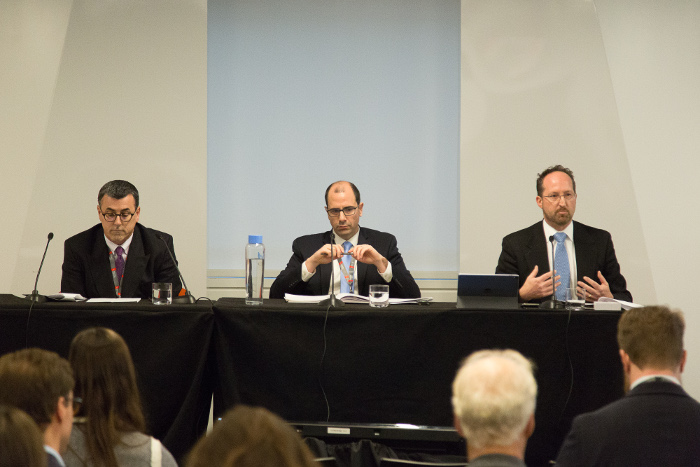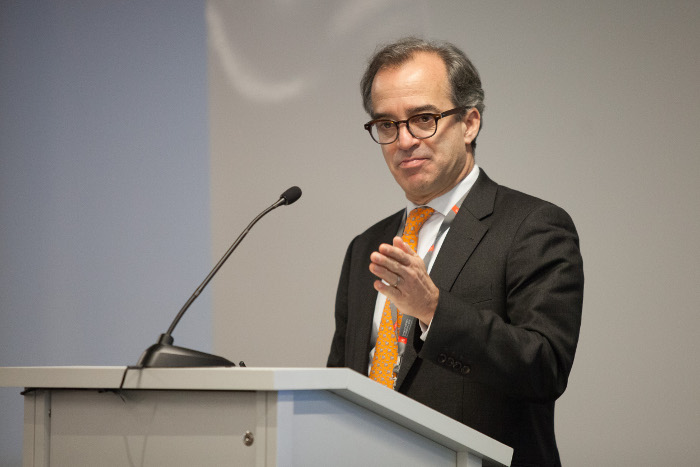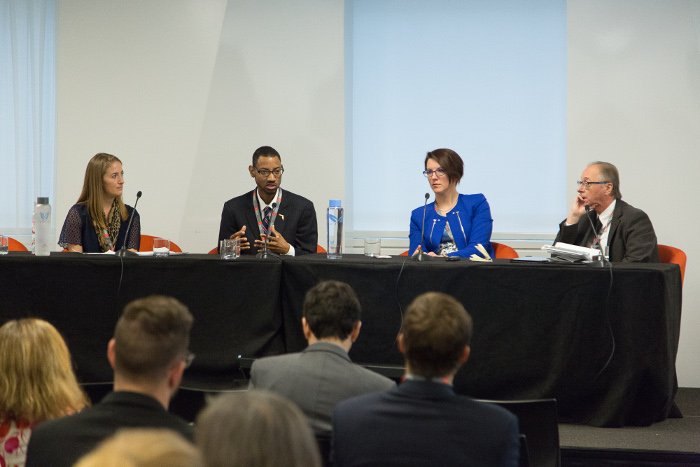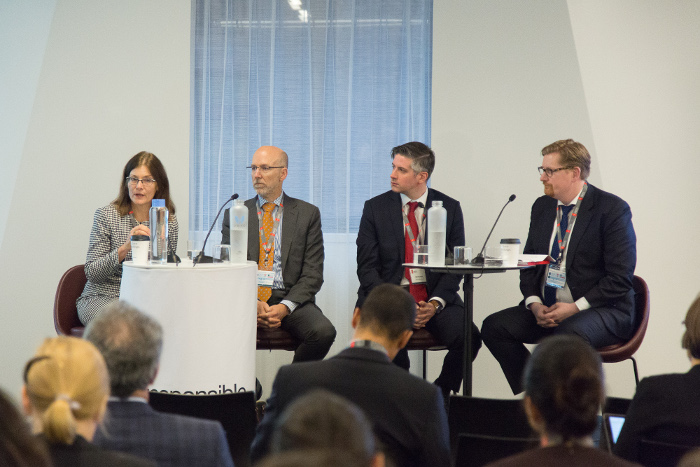The 9th annual RI Americas held at Convene 117 W 46th Street brought together 400+ industry professionals to learn, share and discuss how best to achieve sustainable business and finance goals.
Below is a summary of the sessions that were featured.
Click on each of the following links for the slides:
Plenaries, Stream 1, Stream 2, Stream 3 & Corporates Spotlight
Lead sponsor Welcome Address
Curtis Ravenel, Head of Sustainable Business & Finance, Bloomberg
Plenary 1:
Managing climate risk and return potential in today’s complicated regulatory environment

There is a clear drive among mainstream financial market participants to become more ‘climate aware’. There is also a general perception that information is lacking on corporate disclosure for environmental factors.
There is no ‘one size fits all’ or ‘silver bullet’ to solve corporate disclosure across public and private companies, as well as diverse market caps, geographies, and regions.
The critical first step for financial market participants is at a minimum ‘carbon footprinting’ and establishing a process for corporate engagement on climate change. Beyond looking at carbon, evaluating a company’s transition pathway is an important consideration. Leading investors in the responsible investing space strive to factor in climate change in every investment decision.
Plenary 2:
What do the Taskforce on Climate-related Financial Disclosures (TCFD) recommendations mean for corporate and investor reporting on CO2, and related business and investment behaviour as a result?

Richard Cantor, Member, FSB Task Force on Climate-related Financial Disclosures and Chief Risk Officer, Moody's Corporation, said clear comparability of climate data across companies within industry sectors would be key to the TCFD disclosure framework working, and for bond ratings agencies to look at such disclosure and how might it impact credit ratings.
Fiona Reynolds, Managing Director, Principles for Responsible Investment (PRI), said that on the investor side, from next year the PRI will map its reporting requirements for signatories against the recommendations of the TCFD.
Lauren Smart, Managing Director and Global Head Financial Institutions Business, Trucost (part of S&P Dow Jones Indices), said that the ‘stress testing’ recommended by TCFD for investors and companies, would require a clear process, rather than a strict methodology. She noted, however, that non-listed asset classes could prove to be much harder for following the TCFD recommendations.
Maximilian Horster, Managing Director, ISS-Ethix Climate Change Solutions, warned against too high expectations on TCFD, noting that it looks at climate risk rather than climate impact, whereas at COP23 some were talking about TCFD as ‘unlocking the trillions’. He noted also that ISS-Ethix data showed that the number of companies in the Russell 1000 index reporting climate data was actually decreasing.
Plenary 3:
Engagement. Everyone’s talking about it, but does it work, and if so, how?
Investor engagement plays out quietly behind the scenes, without the fanfare often accompanying shareholder resolutions.
Brian Rice - Investment Officer, California State Teachers' Retirement Systems; Hilary Frisch - Senior Research Analyst for Information Technology at ClearBridge Investments; Bruno Bertocci - Head of the Sustainable Equity Investors Team at UBS Asset Management; and Meredith Miller - Chief Corporate Governance Officer of UAW Retiree Medical Benefits Trust shared their perspectives on engagement and voting outcomes from 2017, the outlook on investor-corporate voting for 2018, what makes engagement successful, and how it can dovetail with other initiatives to build shareholder value.
The panellists agreed that 2017 votes by Vanguard, BlackRock and State Street Global Advisors, among others, represented watershed events that put investor interest in climate risk firmly on the agenda this year. The group also agreed that climate change and diversity will likely continue to be key areas of investor interest in 2018 - with notable engagement initiatives on both topics being planned.
There was also consensus that engagement serves as “free consulting” to companies, and benefits receptive companies in numerous ways, including cost savings and highlighting key points of differentiation not previously communicated by corporations to investors. Successful engagements clearly identify the business case for making the proposed change – such as methane capture and energy efficiency-focused engagements that resulted in clear bottom line savings.
Plenary 4:
How can companies and investors genuinely work together for sustainable profits?

The panel discussion focused on how ESG is being integrated into the investment process. Investor Relations representatives from Tesla and Suncor Energy offered different perspectives on ESG integration at their companies. The proliferation of complex ESG data requests from multiple providers and of integrating non-quantitative data were also mentioned as pain points. oekom research gave an overview of how they incorporate SDGs into their research and ratings. Bloomberg discussed how the ESG investor is not homogeneous but somewhat fragmented and shared their new 2 degree scenario analysis tool.
Plenary 5:
Four x 10 minute presentations on the ESG initiatives companies and investors will be talking about in 2018
Lisa Woll outlined the sustainable finance policy pushbacks in the current administration, and outlined US investor focus on lobbying for next year via the Social Investment Forum, noting that the SIF is pushing back on an attempted ‘evisceration’ of shareholder rights.
Frank Blasio, said The Embankment Project was looking at putting better data on long-term issues such as corporate reputation and branding, and would tie in with existing investor data collection projects. It will shortly name an Advisory council and publish its expectations for its 2018 output.
David Schilling, ICCR’s Senior Program Director for Human Rights, said The Investor Alliance for Human Rights was inviting participation and collaboration from the wider investment community globally. He said its launch was a recognition by investors of a dearth of research work on the social front, and a need to review and build on existing investor work on human rights, and leverage that.
Tracey Rembert, said the tech sector would be in the ESG crosshairs in 2018, because of a plethora of issues from fake news to Russian bots, and information freedom; all of which are starting to represent investment risks. CBIS was focusing on the distressing area of child sexual exploitation online and formulating an investor approach to related engagement.
Keynote Interview:
How investors can make governance and corporate engagement really work
Meredith Miller, Chief Corporate Governance Officer, UAW Retiree Medical Benefits Trust, the $59bn plan for retired autoworkers, was interview by Hugh Wheelan, Managing Editor, Responsible Investor, about UAW's corporate governance programme and engagement as a tool for systemic change. In a broad ranging discussion, Miller noted that the fund is mostly indexed and mostly externally managed. One area where its influence can be clearly felt is in ensuring that managers cover ESG issues when applying for RFPs, where the fund would look at issues such as proxy voting competence and research on human capital issues. A key driver is its promotion of long-term shareholder value, and within that, corporate governance as a risk mitigator and alpha enhancer.
Keynote Interview:
IndexAmericas: The IADB’s new Corporate Sustainability Index (CSI) for Latin America and the Caribbean.
Bernardo Guillamon, Manager of the Office of Outreach and Partnerships, Inter-American Development Bank explained that the CSI could be tradeable, but that it was mostly being used to improve ESG disclosure across Latin America, and in turn as qualitative info for investors, and by multi-Latina companies for meeting international expectations. The CSI is working with Thomson Reuters on improving the LatAm sustainability information set, and with the Argentinian stock exchange on enhanced listing requirements. The CSI will Support the World Benchmarking Alliance on the Latin American section for creating league tables for governments, civil society and investors to quickly and easily compare corporate ESG performance across sectors and markets.
Breakout sessions:
Stream 1 a: How are portfolio managers integrating long-term sustainability factors into investment decisions for better returns?
Two seasoned global equity portfolio managers from Canada and Australia reviewed how ESG considerations are integrated into their investment process frameworks, with a focus on carbon factor risks. Whilst each has a similar goal of de-risking and reducing carbon emissions, their investment process is very different. MFG’s low carbon strategy excludes most materials and energy exposures, whilst PSP’s global equity fund holds roughly 12% in materials and energy. The panel observed that companies are one part of the community and that the transition to a low carbon economy also requires citizens and civil society to do their part.
Stream 1 b: Water risk: whether it’s too much rain/sea water or too little freshwater, water is becoming a serious risk to business continuity, viability and insurance.
Stream 1 c: Smart beta: ESG issues are the under-researched value factors that investors are searching for!

Smart Beta indexing strategies covering multi-variant ESG risks are emerging to better serve institutional investor objectives of return enhancement, risk reduction and improved diversification. ESG drivers include avoiding long-term risks (i.e ‘stranded assets’) and driving positive societal impacts through specific focus on measurable indicators. Smart Beta enables portfolio construction techniques that tilt index-based allocations to companies with strong ESG performance along multiple factors, supporting the business world’s transition to a green economy. With more institutional investors adopting Smart Beta techniques, greater capital is being allocated to companies that outperform on ESG metrics.
Stream 1 d: Applying a long-term sustainable approach to fixed income investing.
The panel demonstrated how ESG integration can support a broad range of fixed income investment strategies, through the experiences of a diverse group of investors. Panellists touched upon ESG in both direct investment and in the selection appointment and monitoring of externally managed portfolios, as a means of mitigating downside risk and generating improved sustainable long term returns. They also discussed approaches towards engagement with issuers and methods for measuring the impact of fixed income investments including through an SDG framework. They then looked forward to what will drive further adoption of ESG throughout the fixed income investment chain including continued education and increased availability of consistently reported ESG data.
Stream 1 e: Green & sustainable bonds: After the initial excitement, what is holding back issuance?
There’s been a massive surge in sustainable bond issuance but it’s been from a very low base and still represents less than 0.5% of the total fixed income market, held back in part by a reluctance by issuers to take on the additional costs of sustainable bonds (second party verification) and workload (reporting on use of proceeds). But there’s genuine optimism because of the "unstoppable economic drivers” inherent in the transition to a low carbon economy. While there’s still an element of the “wild west” about sustainable bonds, there’s significant work being done to create new taxonomies and common standards. And core to the future success is an apparently insatiable demand from investors.
Stream 1 f: What are the methods to incorporate sustainability factors successfully within passive investment?
ESG indexes provide rule-based, transparent and cost-efficient ESG exposure covering an array of issues relevant to ESG investors, including broad ESG, climate risk and thematic issues like renewable energy.
We are experiencing rising demand for passive implementation of ESG strategies, driven by the momentum behind ESG and the general growth of passive investing. Passive ESG investments can be designed to closely track the performance and risk characteristics of the underlying market and can be customized to the needs of particular clients. Broad market passive ESG is a good platform for engagement and proxy voting to support ESG initiatives.
Stream 2 a: How can real sustainability motivate fund managers for better long-term performance?
This session explored how real sustainability might be achieved at three levels - society and the planet; investment organisations; and individuals. How can we move towards a financial system that truly serves the needs of all stakeholders and of the environment by developing an awareness of the real long-term interests of clients and wider society - as expressed in the Sustainable Development Goals, for example - and by paying particular attention to the interests of the stakeholders with the least power - often communities and the environment? We asked ourselves whether everyone in the room could act as though the investment 'chain' was in fact a circle of interconnected and interdependent relationships, in ways that met the needs of every party without disadvantaging any of them.
Stream 2 b: What does the low carbon transition mean in terms of future-proofing investments?
David Richardson and Anita Green discussed how the low carbon transition is merging with other long-term trends such as population growth and urbanization to alter the demand and supply of resources. A focus on industry segments that improve the efficiency of resource usage over the long-term will allow investors to identify opportunities and reduce exposure to potential stranded assets within a portfolio. At a company level, the lack of forward-looking data on investment plans and assets makes risk assessment more difficult, though asset-level business intelligence data is a solution for some sectors. From an asset owner's point of view, Anita discussed how a sustainable investment strategy means incorporating ESG into core decision-making on investments, engagement, and selecting asset managers, and offered advice on how to initiate this within an organization.
Stream 2 c: How the economics and pricing of energy is now a priority for investors: the energy split now and in the short to medium term.
This panel examined pricing dynamics for traditional versus renewable energy sources and the global policy and regulatory undercurrents of climate change. They discussed the impact of climate on investments both in terms of risk and opportunity as well as implications for credit ratings agencies. The panel also looked at engagement with fossil fuel companies as a means for improving the risk/return outcomes and how these activities can support a fiduciary¹s ability to fulfil their obligations. Finally, the panel addressed investor and regulatory demand for improved reporting and disclosure around climate risk from both corporates and investors.
Stream 2 d: What is behind the strong rise in HNW client demand for impact investment and outcome reporting?
The panel explored how asset managers are working with their wealth management arms on impact, the types of investment solutions wealth managers are employing in private and public assets, and the lessons for institutional investment. William Burckart, President, TIIP who moderated the panel said: “While demand by HNW for ESG integration and impact investing has seemingly grown in the past few years, results are mixed when it comes to actual mobilization of capital, the shelf of sustainable investing products in offering, and the credibility and consistency of measurement and reporting.”
Stephen Freedman, Head of Sustainable Investing Solutions - UBS Wealth Management Americas, outlined his work to help address these challenges and expand awareness and understanding about sustainable investing offerings at UBS as well as with the broad world of financial advisors that work with the firm.
Aubre Clemens, Vice President J.P. Morgan, discussed her efforts to build out the platform of sustainable investing approaches that J.P. Morgan offers to clients. She emphasized the work the firm is doing in listed equities in particular and indicated that demand from clients for these kinds of products continues to be high and growing.
Stream 2 e: SDGs and measuring impact of your portfolios – limitations of current approaches, and likely advances?
With the UN SDGs' rapid growth as a tool for driving sustainable and responsible investing, the panel explored how the SDGs can be translated into a strategy to deploy capital on the ground. They began with how these high level development goals were created through a broad stakeholder engagement and then explored how ESG ratings and products are incorporating and addressing the SDGs. The audience raised issues about the challenges and gaps in taking policy objectives and then applying them to investment. These included incorporating the negative as well as the positive impacts of corporations and the geographic and sector concentration that the SDGs represent.
Stream 2 f: Why and how are investment consultants and asset owners assessing ESG integration in asset allocation, manager selection and review?
Consultants have made significant headway in incorporating ESG factors proactively in their investment manager evaluation. On-going monitoring of manager performance on ESG is very similar to the initial research phase.
The larger consultants find it challenging to move ESG/RI to the top of the agenda for plan sponsors but recognize that they can do better. Internal training is a mechanism that they can use to move from models of “centers of excellence” towards cross-team awareness of ESG risks (especially for field consultants).
Stream 3 a: Just because it says its green, doesn’t mean it actually is.
Vonda Brunsting, Director, Capital Stewardship Program‚ Service Employees International Union (SEIU) reminded the audience that a company producing sustainable products, like Tesla for example, should not be given a free pass on every other ESG issue just because it was producing electric cars. Her union, she said, was very concerned about working conditions at the company’s plants, where wages were lower than at other car manufacturers and impossible production targets were being placed on workers. Antti Savilaakso, Research Advisor, Impact-Cubed, came at the problem from a data analysis approach, with a set of slides he described as “the good, the bad, and the ugly”. Using 14 ESG data points, Impact-Cubed had analysed three sustainable funds and found that one, in fact, was anti-sustainable, a second was neutral, while the third was positive, yet all claimed to only invest in stocks that were socially responsible.
Stream 3 b: Executive compensation: are investors getting value for money?
Stephen O'Byrne, President, Shareholder Value Advisors, explained that the pay/performance link in the S&P1500 was fundamentally broken and that the vast majority of pay votes should go against management, but that shareholders do not have the tools to analyse effectively what is wrong. Using some necessarily complex arguments, O’Byrne’s message was ultimately simple: paying managers market level pay for below market performance was a waste of shareholders’ money and the current executive pay model should be replaced with what he called the “perfect pay” model that tied all pay to performance, meaning that it could go down as well as up. Cathy Hansell, Founding Partner and President, Breakthrough Results, said that such a pay model should be based on a much broader view of performance measurement than was currently used; an ESG model. ESG, however, she explained, had been around since the 1970s, but back then it went by a different name – Safety, Health and Environment. She encouraged investors to get information from more than just the board and the CEO. “The VPs of operations are the ones who can tell you whether the company has a long-term future or not,” she said.
Stream 3 c: Women in Finance - Opportunities and practical solutions to increase representation in the industry
Amanda Pullinger, Chief Executive Officer, 100 Women in Finance and Jonathan McBride, Global Head of Inclusion & Diversity, BlackRock discussed why diversity matters, the issues surrounding this, as well as some practical solutions.
Corporate Presentation 1: Suncor Energy
Managing climate change: resilience through strategy
Suncor Energy participated in the first ever opportunity for corporates to present and engage 1x1 with investors at RI Americas, arranged by Leaders Arena. Steve Douglas, VP of Investor Relations and Pat O’Reilly, Director of Sustainability Strategy and Outreach spoke about Suncor Energy’s values-based, triple bottom line approach to value creation and how this approach leads to better decision-making. Steve highlighted that sustainability metrics are integrated into remuneration and spent time outlining the approach to scenario planning in a variety of demand markets, as well as how the company is using technology to drive emissions reductions. Pat reviewed Suncor’s environmental goals and focused on the unique approach and game changing partnerships with First Nations. In publishing a climate risk report, both Steve and Pat thought that the extensive process resulted in many internal and senior level learnings. The audience engaged with Suncor on questions related to the future business model.
Corporate Presentation 2: Becton Dickinson (BD)
Advancing the world of health: Integrating Sustainability into Core Business Strategy
BD participated in the first ever opportunity for corporates to present and engage 1x1 with investors at RI Americas, arranged by Leaders Arena. Sarah Hill, Associate Director, Global Sustainability and Tony DiMeo, Director of Investor Relations spoke about BD’s shared value approach to business planning. Tony began by walking attendees through the BD’s business which focuses on meeting current unmet medical needs. Sarah highlighted the alignment with Goal 3 of the UN Sustainable Development Goals (SDGs) and how mapping to the SDGs is a helpful lens with which to approach future strategy planning. Sarah also spoke about the 4 pillars of their shared value approach: innovation, efficiency, access and empowerment - each pillar having opportunities, risks and goals. She also spoke of their new sustainability report format that is updated throughout the year. Tony ended with BD’s focus on engaging with responsible investors. The audience engaged with BD on questions related to environmental initiatives and approaches to reporting. The corporate presentation and 1x1 meetings received positive feedback from participants.
Closing Remarks

Lee O’Dwyer, West Coast Sales Leader, Bloomberg recapped the two days emphasizing the conference’s balance of practical application and engaging discussion. He reinforced the need for transparent reporting from more companies, while acknowledging the understandable frustration companies feel when rated by a black box, or on metrics that don’t resonate in their industry. O’Dwyer highlighted the discussion around active versus passive investments, Smart Beta and the importance of ESG in optimizing a portfolios tracking error, and connected the theme to engagement reminding the audience how much collective ownership they have of global markets.
























